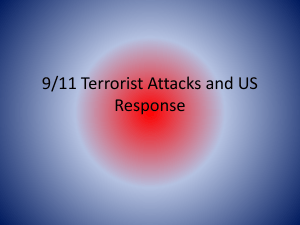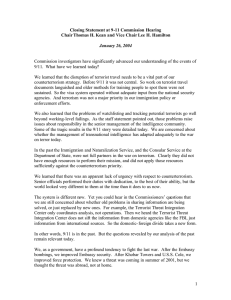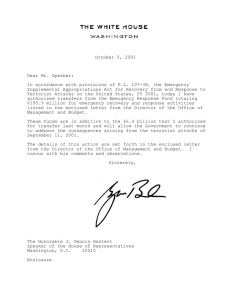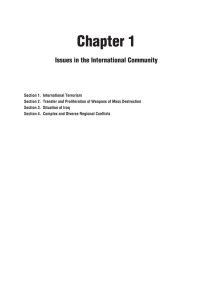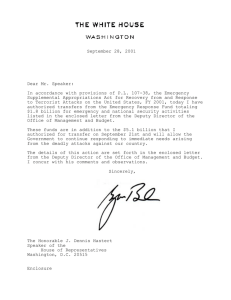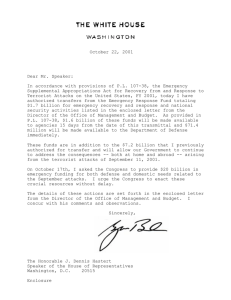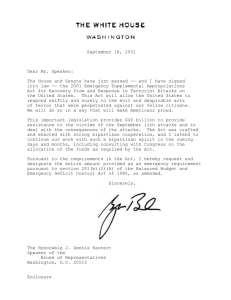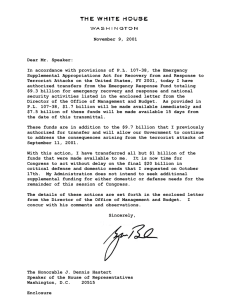Part I Chapter 1 Security Environment Surrounding Japan Issues in the International Community
advertisement
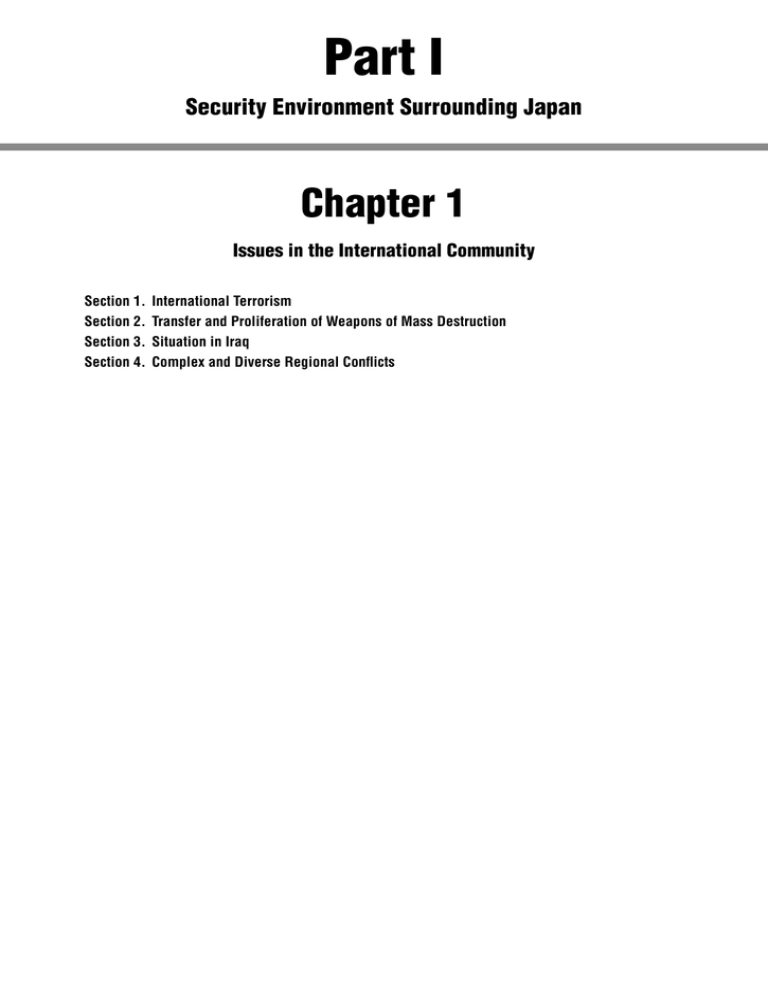
Part I Security Environment Surrounding Japan Chapter 1 Issues in the International Community Section 1. International Terrorism Section 2. Transfer and Proliferation of Weapons of Mass Destruction Section 3. Situation in Iraq Section 4. Complex and Diverse Regional Conflicts Section 1. International Terrorism 1. General Situation The 9/11 attacks that took place in 2001 prompted the entire world to reaffirm the threat of international terrorism, and became the spark that ignited the current fight against terrorism by the United States and other countries. In the invasion of Afghanistan launched by U.S. and U.K. forces shortly after the 9/11 attacks, many of the leaders of Al Qaeda, who were believed to have directed the 9/11 attacks, and the Taliban, who harbored Al Qaeda, were killed or captured. However, Osama bin Laden, Mullah Mohammed Omar and the remnants of their respective organizations are believed still to be hiding in the Afghanistan-Pakistan border region1, and the U.S.-led multinational forces, the Afghan, the Pakistani and other militaries are continuously engaged in clearing operations. Recently in particular, international terrorist organizations have been organized into more decentralized cells, while local terrorist organizations and individuals sympathetic to their ideology have been carrying out terrorist activities on their own or in concert with these international terrorist organizations. Police investigations revealed, for example, that the July 2005 subway and bus suicide bomb attacks in London (U.K.) were not carried out by foreign terrorists, but rather by the sons of Muslim immigrants born and brought up in the U.K.2 Furthermore, in September 2006, the Algerian organization Salafist Group for Preaching and Combat (GSPC) formally announced a merger with Al Qaeda, and subsequently changed its name to Al Qaeda in the Islamic Maghreb (AQIM). This organization is considered to have carried out terrorist attacks last year that targeted the United Nations and Algerian government organizations. In light of the present situation, many countries have enacted stronger counterterrorism measures through domestic legislation. For example, the Russian government passed a new anti-terrorism law in March 2006 that authorizes the downing or sinking of passenger aircraft or vessels hijacked by terrorists, where there is a danger posed of loss of life or a large-scale disaster. On the other hand, in February 2006, the German Federal Constitutional Court decided that the provision of the Aviation Security Law stipulating that hijacked planes may be shot down is unconstitutional and called for its repeal, underlining the fact that views on counterterrorism measures vary from one country to another. Furthermore, countries have banded together in an international coalition, continuing to commit not only military forces, but also diplomatic, law enforcement, judicial, intelligence and economic resources, and counterterrorism measures are also being implemented through multinational frameworks such as the United Nations, the G8, and regional cooperation organizations. Specifically, these efforts include ensuring stability and supplying recovery/reconstruction assistance to Afghanistan and Iraq, enhancing systems for exchanging counterterrorism intelligence, reinforcing international legal frameworks to sternly punish terrorists, cutting off terrorist funding and strengthening air security (including the prevention of hijacking), tightening immigration controls, adopting more effective approaches to ensure the non-proliferation of weapons of mass destruction and regulation of man-portable air defense systems (MANPADS), assisting developing countries with inadequate counterterrorism measures to enhance their capabilities, and taking steps to reduce or eliminate poverty, economic and social disparities and inequality in developing countries. 2. Fight Against Terrorism in and around Afghanistan The United States together with other countries has continued military operations against the Taliban and Al Qaeda in and around Afghanistan since October 2001, shortly after the 9/11 terrorist attacks. In the Arabian Sea, naval vessels from various countries have endeavored to keep these international terrorists from relocating to other areas by sea and to prevent the proliferation of terrorism from Afghanistan. In Afghanistan, attacks orchestrated by the Taliban have been increasing, and the security situation remains unstable. The number of terrorist bombings and attacks are particularly prevalent in the southern and eastern —— Part I Security Environment Surrounding Japan areas adjacent to the border with Pakistan. In addition, there have also been scattered terrorist bomb attacks in Kabul, the capital of Afghanistan, and in the northern and western areas, which were relatively stable and peaceful. This situation has led the Afghan military, multinational forces and others to collaborate in mopping-up operations mainly in the south and east of the country. The International Security Assistance Force (ISAF3) has set up five Regional Commands under the General Headquarters in Kabul, and provides support for the Afghan government in maintaining peace in the whole of the country. There are also 26 Provincial Reconstruction Teams (PRTs) to improve the security of the environment, and to conduct reconstruction assistance activities in the whole of Afghanistan. Similar activities are also continuing through the United Nations Assistance Mission in Afghanistan (UNAMA). Pakistan, which borders Afghanistan, is cooperating in the fight against terrorism, with the implementation of terrorist mopping-up operations in border areas. In addition, it has been confirmed that Pakistan will also cooperate with Afghanistan in enhancing cooperation to counteract terrorist activities4. However, it is assessed that Al Qaeda and other groups have been providing training to terrorist operatives in the Federally Administered Tribal Areas (FATA) of Pakistan5, and it is pointed out that Al Qaeda has reestablished itself in the border area and now seems to have turned its focus toward Pakistan and attacks on the Pakistani government and people6. 3. Terrorist Attacks around the World In Iraq, since Saddam Hussein’s regime was brought down by U.S. and U.K. military operations in 2003, it seems that terrorists have been flowing into Iraq due to degraded security and insufficient border controls, and terrorist attacks are occurring frequently, targeting not only U.S. and other soldiers, but also Iraqi citizens and foreign nationals. While the attack capabilities of terrorist groups such as Al Qaeda-affiliated armed groups are being lowered due to mopping-up operations by multinational forces and Iraqi Security Forces and also due to a confrontational attitude of the local residents, the activities of these terrorist organizations continue to be a major obstacle to the rebuilding of Iraq. (See Section 3) Terrorist attacks have also continued in countries surrounding Iraq. In Turkey, from May to June 2007, a number of terrorist incidents occurred in Ankara, Istanbul and Izmir on the Aegean Coast, that were considered to be the work of anti-government organizations such as the Kurdistan Workers’ Party (PKK). In December, in response to a PKK attack on Turkish army troops in October 2007 near the border with Iraq, the Turkish army initiated a mopping-up operation, focusing on PKK bases in the Kurdish region of Northern Iraq. In Lebanon also, against the backdrop of an unstable political situation, in June 2007, a member of parliament was assassinated by terrorists, and in December 2007, Army General Francois al-Hajj was assassinated. In Algeria, last year there were a series of terrorist attacks targeting the government and army, including simultaneous bomb attacks on government buildings, the attempted assassination of the President of Algeria, a suicide bombing on the barracks of the Algerian Coast Guard, and bombing of U.N. organizations. Al Qaeda in the Islamic Maghreb (AQIM) claimed responsibility for these attacks. Furthermore, the scope of activities of AQIM has not remained exclusively in Algerian borders, with it being pointed out that the group is recruiting and providing training7 for Islamic extremists in North African countries and plans to expand its mission throughout the entire region and beyond8. Southeast Asia is still a region subject to frequent terrorist threats, although some progress has been made in controlling terrorist organizations. Between 2002 and 2005, Indonesia suffered large-scale terrorist attacks, in which the involvement of Jemaah Islamiya (JI), a radical Muslim organization, is suspected9. Since 2006, however, there have been no large terrorist attacks. In 2007 the leaders of JI Zarkasi and Abu Dujana were arrested, which are notable successes in controlling terrorist activities. In the Philippines, the Communist group the New People’s Army has long been the largest threat to domestic security. While the Philippine government has continued to engage in consultations with the Molo Islamic Liberation Front (MILF) towards peace, it —— conducts mopping-up operations against the Abu Sayyaf Group (ASG), leading to a number of results, including the killing of ASG leaders and reduction in membership. At the same time southern Thailand has witnessed frequent attacks and bombing/arson incidents by radical Muslim separatists against military and police facilities, and there is currently no prospect of the situation being alleviated. South Asia, too, has witnessed frequent large-scale terrorist attacks. In particular, in Pakistan last year former Prime Minister Benazir Bhutto was assassinated and terrorist attacks targeting government organizations and security-related facilities such as the military and police frequently occurred. In 2008 there have been suicide bombings at a High Court building and at the Naval College. In addition, in 2007 in Sri Lanka, a terrorist attack occurred in the center of Colombo that is suspected to have been perpetrated by the Liberation Tigers of Tamil Eelam (LTTE). In January 2008, the ceasefire agreement broke down between the Sri Lankan government and the LTTE, and it is feared that this will lead to a future rise in terrorist attacks. (See Fig. I-1-1-1) Fig. I-1-1-1 Major Terrorism Incidents Around the World (May 2007- May 2008) Republic of North Ossetia-Alania (Russia) • November 2007 Bus bombing; 6 people killed and 13 injured Algeria • July 2007 Suicide bombing in front of national army barracks; 10 people killed and 35 injured • September 2007 Assassination attempt on the president; 22 people killed and 107 injured • September 2007 Suicide bombing in front of Navy barracks; 30 people killed and 47 injured • December 2007 Serial terror attacks on government, U.N. facilities; 37 people killed and 177 injured Ma’rib (Republic of Yemen) • July 2007 Tourist site bombing; 10 people killed and some injured *Excluding Iraq, Afghanistan and Thailand Turkey • June 2007 • May 2007 Bombing (Ankara); Bombing; 3 people killed and 4 injured 6 people killed and more than 80 injured Dagestanskaya (Russia) • July 2007 School bombing; 4 people killed Beirut (Lebanon) • September 2007 Anti-Syrian member of parliament bombing; 7 people killed and more than 20 injured • December 2007 Assassination bombing of General Hajj; 4 people killed and more than 10 injured • January 2008 Terrorist attack at the American Embassy convoy; 4 people killed and more than 10 injured • September 2007 Bus attack; 12 people killed Pakistan • July 2007 Raid of “Red Mosque”(Lal Masjid); High number of casualties • October 2007 Assassination attempt on former Prime Minister Benazir Bhutto; more than 130 people killed and more than 430 injured • December 2007 Assassination of former Prime Minister Bhutto; more than 20 people killed Colombo (Sri Lanka) • November 2007 Bombing; 17 people killed and more than 40 injured • January 2008 Military bus bombing; 5 people killed and 28 injured Mogadishu (Somalia) • June 2007 Suicide bombing of the Prime Minister’s residence; more than 7 people killed and more than 10 injured —— • October 2007 Serial bombing attacks; 1 person killed and 10 injured • January 2008 Military vehicle bombing; 5 people killed and 110 injured Manila (Philippines) • November 2007 House of Representatives bombing; 2 people killed and 11 people injured Mindanao Island (Philippines) • May 2007 Market bombing; more than 5 people killed and more than 30 injured • October 2007 Bombing; 1 person killed and 26 injured

